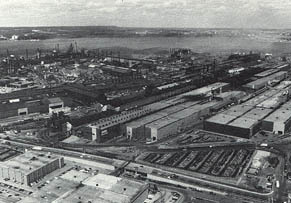Stelco: Teamwork
and Technology in Action
In 1910, the flamboyant Canadian financier,
Max Aitken, skillfully merged several struggling steel firms to form The
Steel Company of Canada. His goal: create, a single enterprise to meet
Canada's fast-growing need for steel.
Over the years, Stelco has employed 130,000
Canadians, refined 160 million tons of steel and invested $3.5 billion
in new facilities. Along the way, Stelco people have set the industry pace
in corporate citizenship, technical innovation and environmental quality
control. The firm became a virtual "steel supermarket"—the
widest range of basic and finished steel products on the continent. Its
growth and success can be traced to the economic surges that chart Canada's
history. Today, Stelco is beginning to reap the many benefits of an all-out
cost control and quality enhancement program launched in the mid 80s: a
$500 million dollar effort designed to set new standards in teamwork and
technology.
The progress has been significant. Stelco
has been downsized and rebuilt to reflect the fastchanging steel scene.
Today, this world class organization is two distinct divisions: Stelco
Steel, the core business concentrating on basic steel production; and Stelco
Enterprises, a group of wholly or jointly owned business units which make
and market a wide range of finished steel products plus a communications
and printing company. Stelco also incorporated its Technology Division
as Stelco Technical Services Limited (Steltech), a company devoted to providing
engineering, research and technology support to innovations availablefrom
Stelco Steel and Stelco Enterprises. Steltech also provides these services
and innovative technology to outside customers.
  |
| 1. Hilton Works, Hamilton,
Ontario, is Stelco Steel's 2. Technological leader: The Stelco-developed
Coilbox is a major advance in the science of hot strip rolling. Now in
use by steelmakers in many parts of the world, the Coilbox important technological
is just one of a number of Steltech. |
In virtually all facets of its extensive
steelmaking and processing operations, Stelco Steel has enlisted the aid
of the computer—and the latest in high technology. At its 1100-acre Hilton
Works complex in Hamilton, for instance, two new continuous casting machines
were recently commissioned. These units cast molten steel into slabs and
blooms of exceptional quality. And at high productivity rates, with significant
cost savings in energy, manpower and material handling. Indeed, Stelco
Steel can now continuously cast over 80 per cent of its raw steel.
Throughout Stelco, people have changed,
too. In both the Steel and Enterprise divisions, they have adopted leading
edge technology with enthusiasm, and have begun to apply new techniques
in quality control, interpersonal communications and problem solving.
Today, Stelco Steel produces about one-third
of all Canada's steel. Stelco Inc.'s consolidated annual sales are more
than $2.5 billion and fixed assets exceed $1.6 billion. The Corporation's
business plan includes growth in both new and traditional markets. Its
people and processes represent the best the Canadian steel industry has
ever seen. As a dynamic leader on the international steel scene, Stelco
is geared to meet the needs of Canadian industry well into the 21st century.
Technology and teamwork: the people of Stelco are busy setting new standards
for both.

